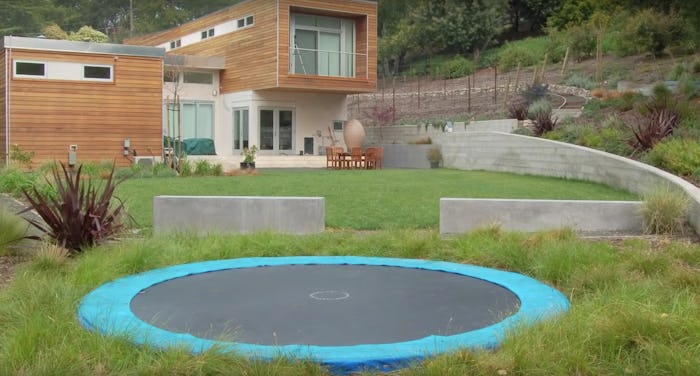Life
Here's What You Need To Know About In-Ground Trampolines Vs. Standard Trampolines
Of course kids and parents alike are familiar with above-ground trampolines — hasn’t everyone played popcorn on one at least once in their lives, or begged for one for their birthday? Now, in-ground trampolines are officially a thing, which has parents wondering if in-ground trampolines are safer than above-ground trampolines for their kids.
The most common types of injuries that happen while jumping on the trampoline, as reported by the American Academy of Pediatrics (AAP), are sprains, strains, and contusions. The American Academy of Orthopaedic Surgeons (AAOS) has found that most children are hurt on trampolines as a result of falls on the trampoline mat, frame, or springs, collisions with other jumpers, trying to do stunts gone wrong, and falling off the trampoline onto a hard surface.
In-ground trampolines, also known as sunken trampolines, are installed in the ground so the jumping surface is level with the yard around it, rather than a few feet above on stilts. Just like above-ground trampolines, in-ground ones can have nets added for extra safety. Because they’re not as high off of the ground and don’t appear to stand on spindly legs, parents looking to buy a trampoline for their kids might think an in-ground option will be safer for their little ones.
The AAP begs to differ — their current policy is to advise against any and all activity on trampolines, whether in-ground or above-ground. Why? Their data shows that 75 percent of trampoline injuries occur when multiple people are jumping on the mat together, and the injuries from falling are much rarer. The smallest and youngest participants are usually at greater risk for significant injury when jumping with a group, specifically children 5 years of age or younger, who sustained 48 percent of the injuries the AAP documented.
However, the AAOS actually does recommend that the jumping surface of a trampoline be placed at ground level to reduce the number and severity of injuries.
While their data backs up the AAP — that nets and other safety measures don’t prevent most trampoline injuries, since three-fourths of injuries involve two or more children on the trampoline at the same time — they say that eliminating the height of the trampoline from the equation can help make fall injuries less severe.
Whether parents choose an above-ground or in-ground trampoline for their child, the AAOS recommends the following to keep them safe:
- Always supervise children while jumping on a trampoline, and act as spotters if there is no net.
- Do not allow children younger than 6 years of age to use trampolines.
- Do not attempt stunts or high-risk maneuvers without proper training and safety equipment, like a harness.
- Only allow one person to jump at a time.
- Place the trampoline jumping surface at ground level.
- Regularly inspect the trampoline for wear and tear, and replace damaged or worn parts.
- Remove trampoline ladders after use to prevent unsupervised access by young children.
Ultimately, purchasing an in-ground or above-ground trampoline can be dangerous for children if they’ll be jumping unsupervised or in large groups. But, it sounds like bringing your trampoline down to ground level can’t hurt.
